NORTH WALES COAST RAILWAY:NOTICE BOARD
Rheilffordd arfordir gogledd Cymru: Hysbysfwrdd
15 February 2021





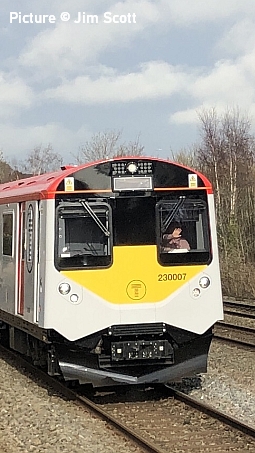
Forthcoming events
(see also our Calendar page for venues)
Note: we have removed all entries relating to meetings as the events are cancelled.
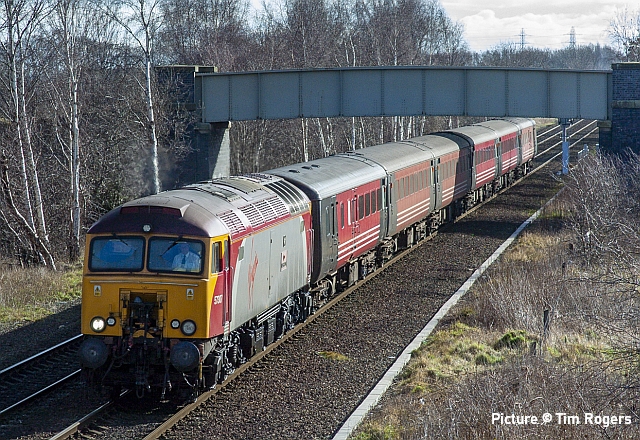
A pink nameplate for Valentine's Day: on 14 February 2006, 57 307 Lady Penelope passes Shotton with the 10:03 Manchester - Holyhead. Picture by Tim Rogers.
THE NEXT
UPDATE WILL BE ON TUESDAY EVENING 23rd, DUE
TO AN EXCESS OF ZOOM MEETINGS. - Charlie
Read about the Bala Lake Railway's urgent appeal.
Read about the Bala Lake Railway's urgent appeal.
Class 37/4s in the news
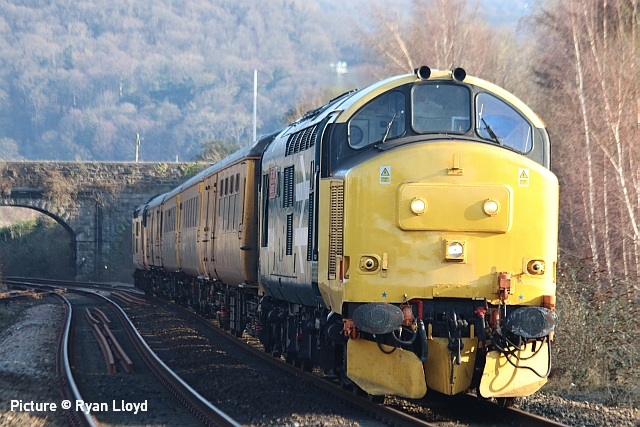
Memories of the 1990s were revived on 12 February, when Colas Rail provided two of the heroes of the North Wales loco hauled fleet for a Derby - Holyhead and return Network Rail measurement trip. Ryan Lloyd was at Llandudno Junction to see the train, headed by 37 418, now wearing a decent replication of the original 37/4 livery, complete with 'Highland Stag' adornment and nameplate An Comunn Gàidhealach which is an organisation with charitable status that aims to support and develop the Gaelic language, history and heritage. On the rear, another North Wales stalwart, 37 421.
In its North Wales period 37 418 was East Lancashire Railway, and carried the Regional Railways colours, and later was one of the first to be repainted in the 'red and gold' of English, Welsh and Scottish. 37 421 was 'The Kingsman' and also had Regional Railways livery; when later bought by preservationists, this was restored, but when Colas took it over they repainted it in their garish scheme.
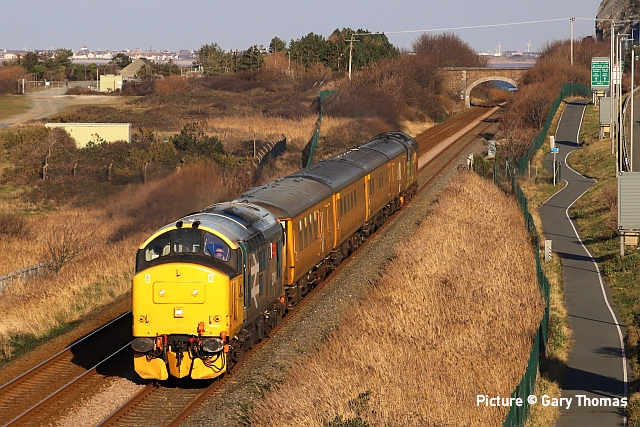
Gary Thomas was in the sunshine at the 'Iron Bridge' Dwygyfylchi ...

... 37 421 on the rear.

The return train at Llandudno Junction (Ryan Lloyd)
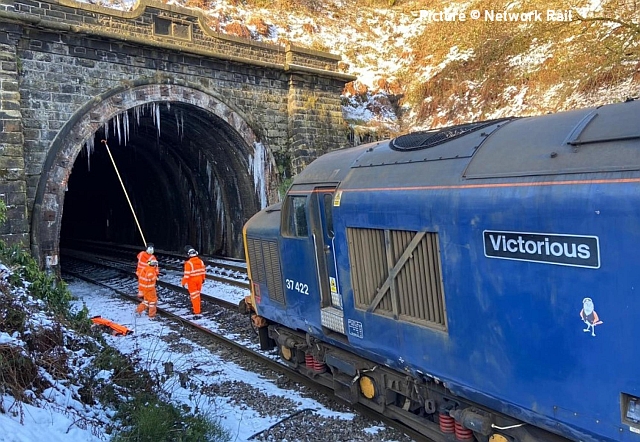
Meanwhile, in the High Pennines, another Coast line fleet survivor, 37 422, ex-Robert F. Fairlie (see Charlie's tribute originally written for the Manchester Locomotive Society magazine, The Mancunian) was on duty assisting a Network Rail crew with the removal of icicles in Standedge Tunnel. As can be seen in Network Rail's image, it has gained the name Victorious, and mysteriously a Stratford Depot 'Cockney Sparrow.'
Network Rail tell us that the interior of the tunnel maintains a temperature of around eight degrees throughout the year, but icicles appear near the portals in cold weather, often long enough to put train drivers at risk.
News items
On Sunday 7 February, the Wales and Borders Rail franchise operation was officially handed over by KeolisAmey to the Welsh Government's operator of last resort, Transport for Wales Rail Limited, a subsidiary of Transport for Wales, while AmeyKeolis's Infrastructure arm will retain an involvement in delivering some key projects such as the Core Valley Lines.
No immediate staff changes, except perhaps at high level, and expected, nor changes of train livery; brand name and livery of Transport for Wales will be retained. it's to be hoped that the new owners keep in mind their routes in England.
The UK Department for Transport recently issued an 'open consultation' about possible changes to services in the Manchester area to avoid the chaos and congestion caused by the over-ambitious timetable implemented in 2018. Two of the three suggestion options would affect travellers using the North Wales - Manchester route.
One idea is to divert the North Wales trains to call at Manchester Victoria and on to Stalybridge. missing out Oxford Road and Piccadilly stations and the Airport branch. Another is to run to Piccadilly via the Chester - Stockport Mid-Cheshire route, calling at Northwich, Knustford, Altrincham and Stockport, offering the main mid-Cheshire stations an improved service, while the stations in England on the current route would be served by a Northern service. Read it at this link.
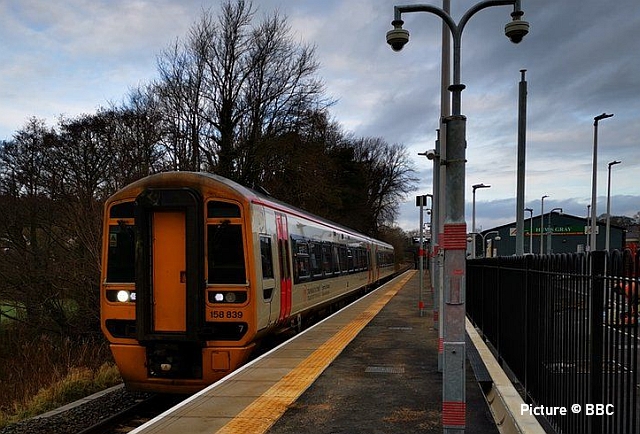
On the Cambrian line, the re-opened station at Bow Street on the Aberystwyth line opened on 14 February, and according to the Real Time Trains, trains are actually stopping there. It is intended partly to be a 'park and ride' station for Aberystwyth. The first train (above, worked by 158 839) was not for public use in case crowds of railfans turned up.
Bustitution explained - by Ken Robinson
An e item that caught my eye in the jast issue was Jim Johnson's 'Paperwork'.
The revised timetables and 'bustitution' from 1935 got me thinking. Having checked dates etc. I'm almost certain that this was due to a collapsed bridge over the Afon Dwyfach about half a mile north of Bryncir station. Sometime in June 1935 (no specific date sorry) there was a severe rainstorm/cloudburst on the nearby mountain called Mynydd Graig Goch (610m.) which resulted in terrible flooding in the area.
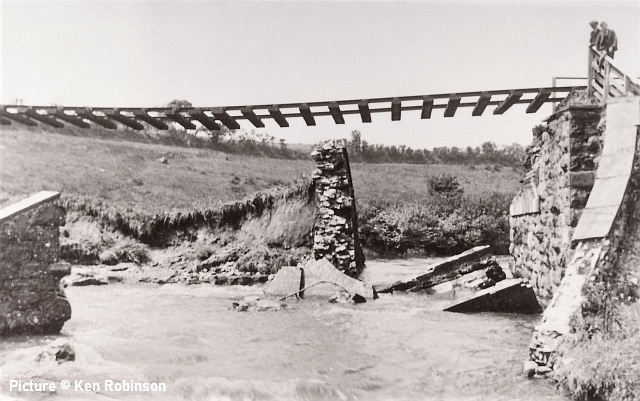
This photograph shows the damage. For decades afterwards hardly anything grew on that mountain as the ferocity of rain had eroded the topsoil. My late father remembered going as a small child with his father by bus from Caernarfon to see the damaged bridge (and possibly others) and the nearby floods. Hope this helps!
Things seen while exercising
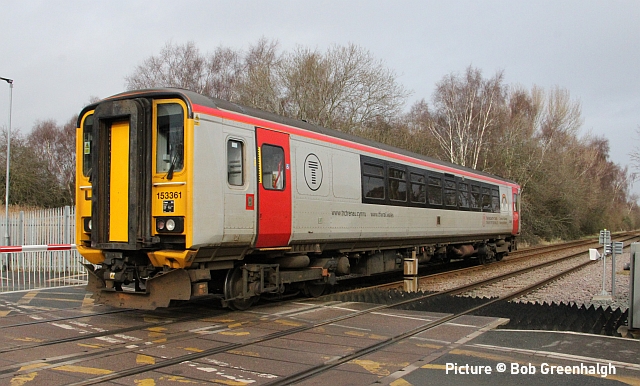
Not a common sight on the Chester - Wrexham line, a single class 153: 153 361 working empty stock from Wrexham to Chester depot on 15 February (Bob Greenhalgh).
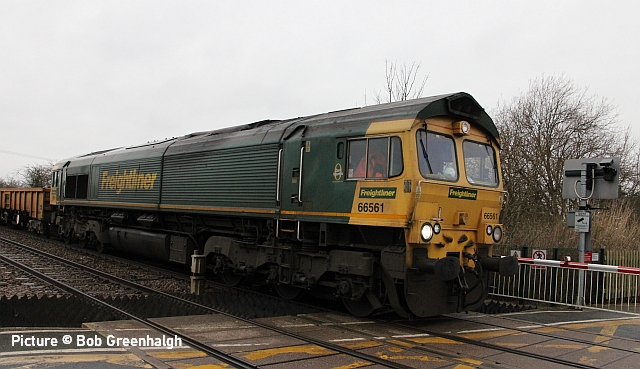
The same site on 14 February, with 66 561 hauling a rake of Network Rail spoil wagons (Bob Greenhalgh).
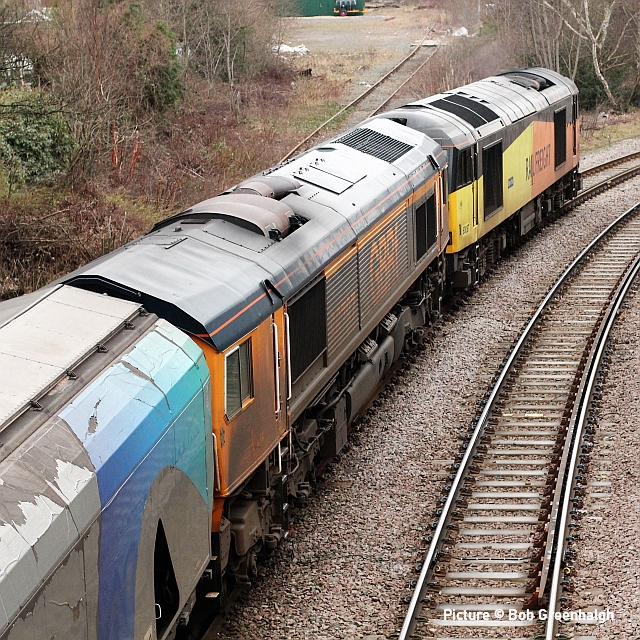
Skelton Junction on 14 February: empty Biomass train with 60 087 leading with
an 66 in tow that was too dirty to read the number! ( 66 787 according to Real Time Trains: GBRf is one of the companies that now makes this information public.) Picture by Greg Mape.
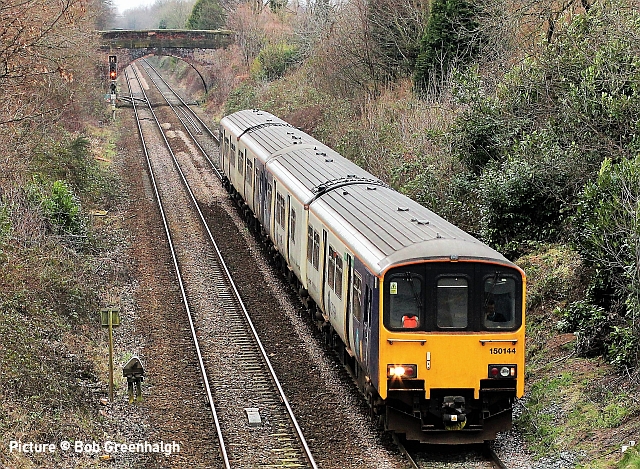
150 144 working a Chester - Manchester Piccadilly service. Will we see Transport for Wales trains coming this way - see above. (Greg Mape).
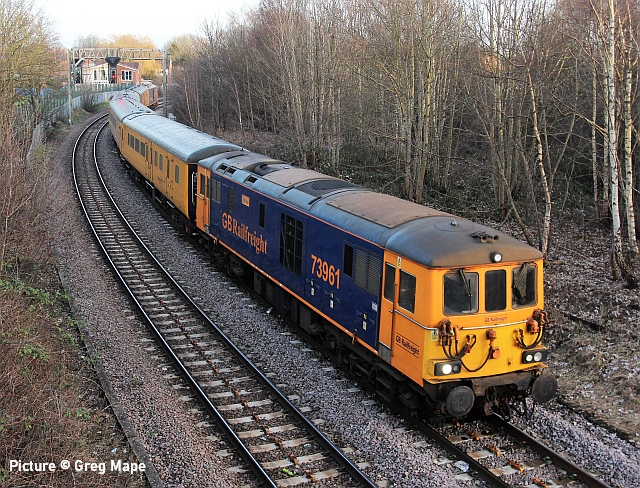
Passing through Timperley on the Skelton - Deansgate Junctions curve after
4pm on 15 February: 73 961 leading and 73 965 on the rear of a Network Rail train from Derby to Crewe via Derbyshire, Merseyside, North Wales & Cheshire! Picture by Greg Mape. The itinerary included the Liverpool Loop tunnel, hence the hiring from GB Railfreight of the Class 73 locos which are fitted to take power from the third-rail electrcal supply as well as from their diesel engines. Diesel locos would pollute the tunnel and its stations.
The journey started at Derby at 13:14 and and ended at Crewe at 04:39 on 16 February. Note the 'anchors' between the rails to deter the track from moving sideways on this sharp curve.
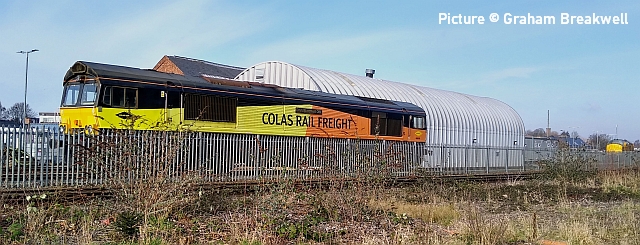
66 850 David Maidment OBE at Coleham depot on 12 February with 97 304 John Tiley at the buffer stops.
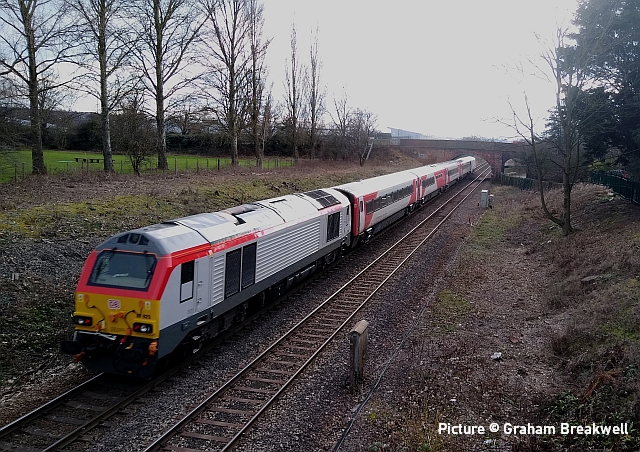
67 026 propelling the 11.55 Crewe to Newport trial run, passing Meole Brace Golf Course, Shrewsbury, 12 February (Graham Breakwell).
Lockdown - by Robert Daralaston
Pictures taken on 11 February in the course of two essential journeys between the village of Goostrey and Crewe - my first rail journeys for eleven months.
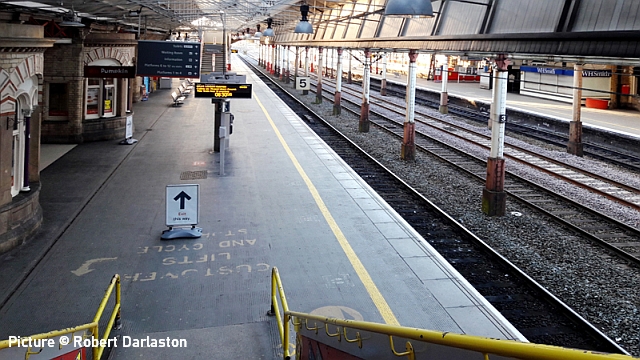
The first shows clearly the effect the lockdown has had on rail travel. It
was taken at Crewe at 08:30, ten minutes before a Glasgow - Euston train was
due to arrive. Normally, platform 5 would have been thronged with people,
but yesterday no one was in sight (though a couple of brave souls were
lurking in odd corners). Similarly, a delayed Cardiff - Manchester train
and a Euston - Liverpool train were both due at platform 6 (at the right of
the photo). Note that the bookstall on platform 6 is closed.
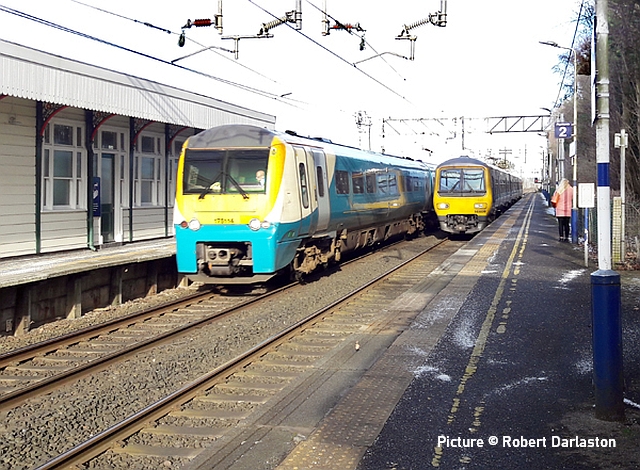
The second photo was taken at Goostrey at 13.40. It shows a 175 rushing
through with the 08.59 Carmarthen to Manchester as a 323 arrives with the
13.01 Manchester to Crewe which picked up one other passenger in addition to myself. The picture also shows the 1891-vintage LNWR building which was
nicely restored in 2019.
The scene at Crewe and the light loading of the two local trains I used make
one very concerned for the future of the railways as it seems likely many
passengers will have deserted rail for ever. Very worrying.
Steam era scenes - by Peter Neve
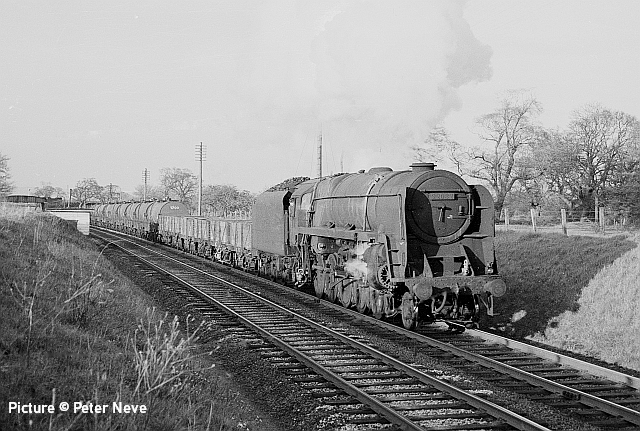
With its right hand side cylinder cover missing, Birkenhead (Mollington Street) - based Riddles 9F 2-10-0 92082 hauls a fitted train of tank wagons through Mickle Trafford on 11 April 1967. In the background is the Cheshire Lines Committee bridge carrying the track westwards in the direction of Chester Northgate station and Bidston.
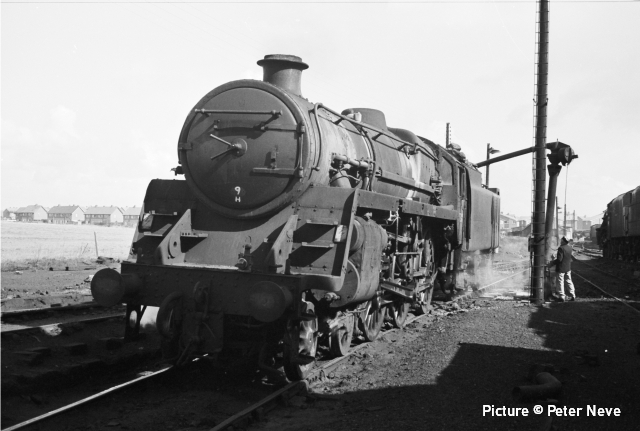
Standard Class 5 4-6-0 73011 is having its tender replenished at Chester MPD in readiness for the return journey to its home shed of Patricroft (9H) on 23 March 1967. The fireman is looking towards the tender and will close the valve of the water crane when water overflows from the tank. He may also be concerned at the height of the coal piled up in the tender, which seems to be precariously balanced. Almost a year later the locomotive will be reduced to a pile of scrap metal in the premises of Cashmores at Great Bridge. 73011 was previously allocated to Holyhead and Llandudno Junction and was a regular performer in the Chester area.
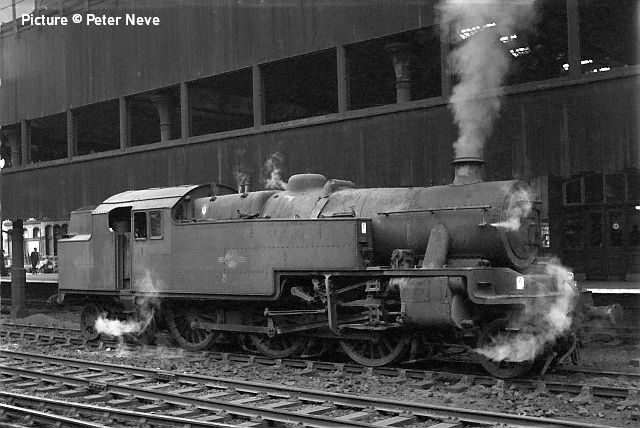
Stanier 2-6-4 42548 stands at Manchester Victoria station on the 13th April 1966 waiting for its next banking duty assisting heavy trains up the Miles Platting incline. Based at Newton Heath shed at the time, it was transferred to Birkenhead (Mollington Street) a couple of months later. It was withdrawn from there and cut up at Cashmores (Great Bridge) in May 1967.
Looking back with David Pool: Llangollen (etc), 2000 - 2004
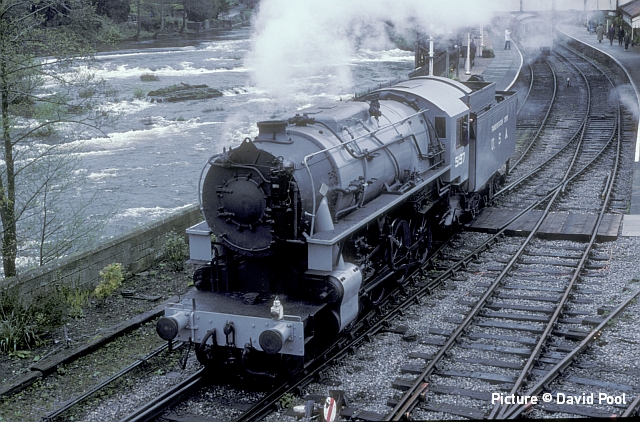
The “Austerity” classes of tender locomotives built in Britain during the 1939-1945 war were very similar to those built in the U.S.A. which were exported to many countries (including to Britain). Although very few of the British built locomotives have survived, many of the U.S.A. built locomotives are now preserved, including six in the UK. The S160 Class No.5197 photographed at Llangollen on 29 April 2000 has a typical history. It was built by the Lima Locomotive Company in Ohio in 1945, and sent to China in 1946, where ir remained until it was bought in 1995 and restored at Llangollen, entering service in 1998. In 2001 it was sold to the Churnet Valley Railway, and has subsequently visited many of the other preserved lines in the UK.
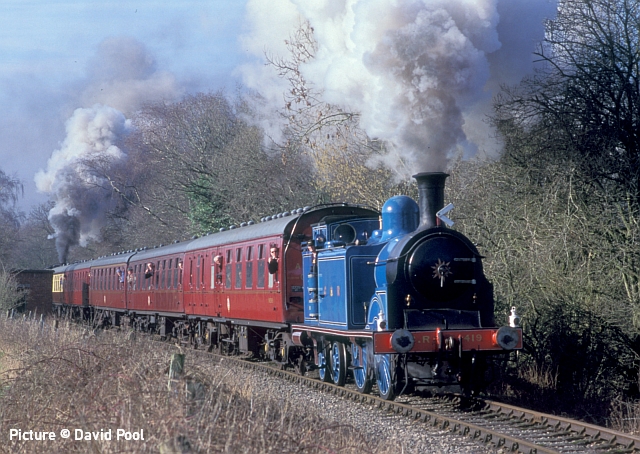
On 23 February 2019 I went to the Churnet Valley Railway to photograph the visiting Caledonian Railway No.419 working on the branch to Ipstones. From Leek Brook Junction there are gradients between 1 in 40 and 1 in 59 for five miles, so the Caley Tank needed some assistance with even a five coach train. It was clear that the banking locomotive was doing most of the work.
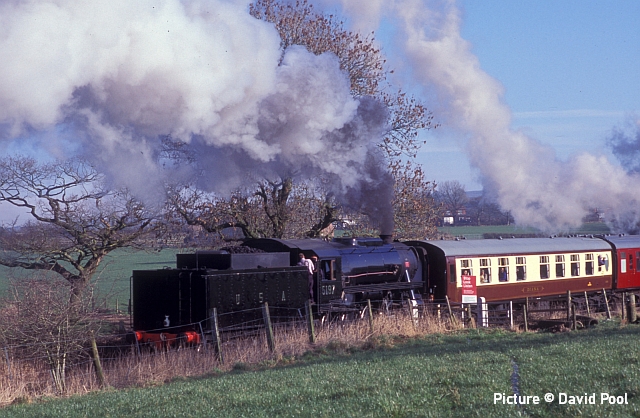
The Banker turned out to be No 5197, now in a black livery, which looked and sounded very impressive. If you want to see an S160 working hard, go to the CVR on a Gala Day and make sure you go to the Ipstones branch!
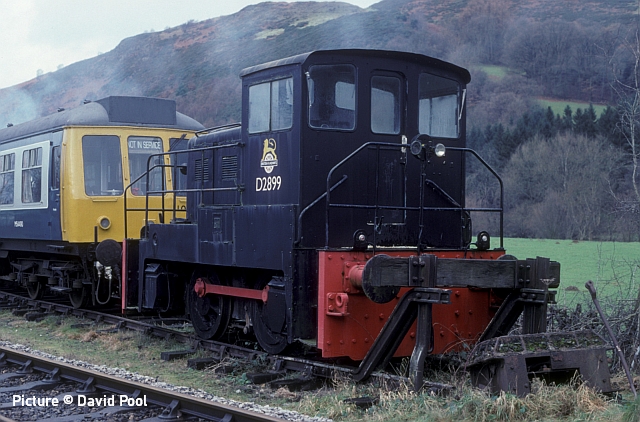
In the siding at Glyndyfrdwy on 6 January 2001 was D2899. This is a Yorkshire Engine Company Diesel Electric built in 1961 and reported to have been used at Penyffordd. The loco number is fictitious, in that this particular locomotive was never owned by BR.
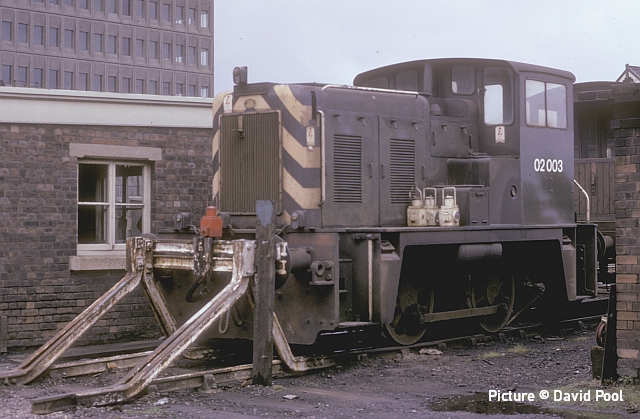
The BR version was Diesel Hydraulic, and examples could be found at Allerton and usually at Liverpool Exchange, where 02 003 was photographed on 8 June 1974. This was previously D2853.
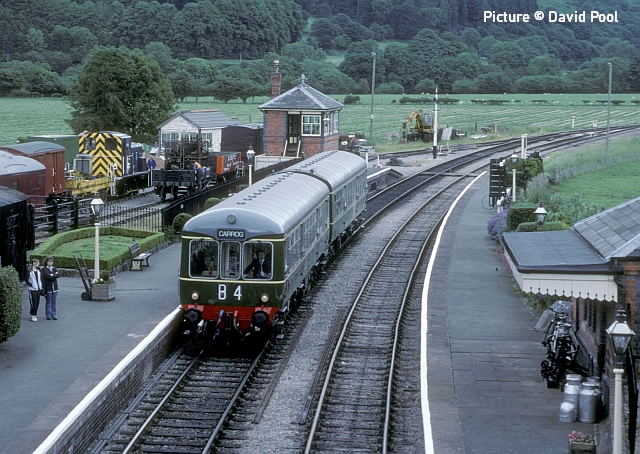
Five sets of the Class 109 Diesel Multiple Units were built in 1957 and 1958 by D Wickham, and based on the Eastern Region. Being non standard, they were out of place with the other DMUs operating at that time, and in 1961 two sets were sold to Trinidad. The three remaining sets operated in East Anglia, and one of these went into Departmental use, eventually arriving at Llangollen for restoration. 12 June 2004 was the day it went into service, and the set E50416 /E56171 is photographed at Carrog, looking in superb condition. The interior had been gutted to remove the asbestos which had been used in the construction of the floor, and little more than a body shell had been left.
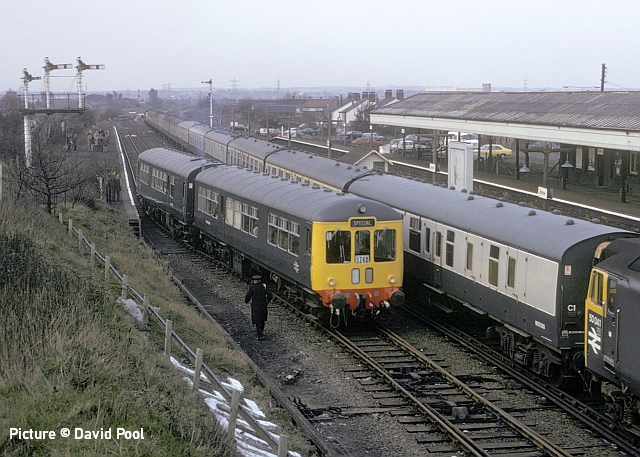
Looking back at my list of slides, I found that I had seen this unit before. The Grand National on 5 April 1975 had brought some important visitors to Aintree, including the General Manager of the Eastern Region, who arrived in DB975005/975006. It is leaving Aintree Sefton Arms at 17:38 for Sheffield with headcode 1Z49, and passing another Special headed by 50 041.
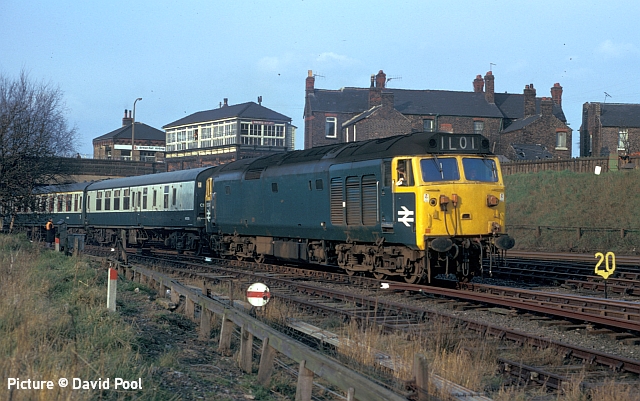
At the time I was more interested in the Class 50, which was due to depart for Euston at 1753, so I moved to a suitable location away from the station on the line to Bootle Junction and the Bootle Branch. Pairs of Class 50s were used in 1973 on the 07:40 Lime Street to Glasgow trains, but I had never seen one at Aintree before.
Driver Jim Scott's week
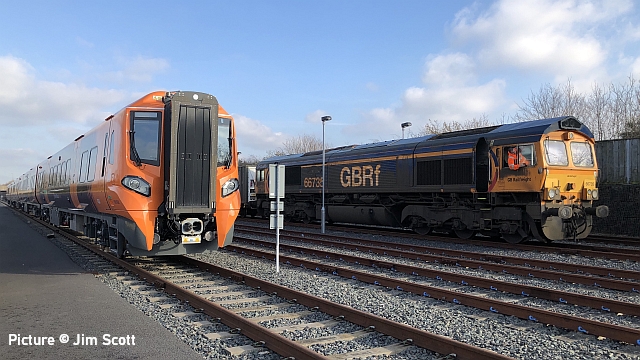
A new class 196 in store in Donnington MOD depot with 66735 waiting to leave for Didcot via Shrewsbury and Crewe to save a run round.
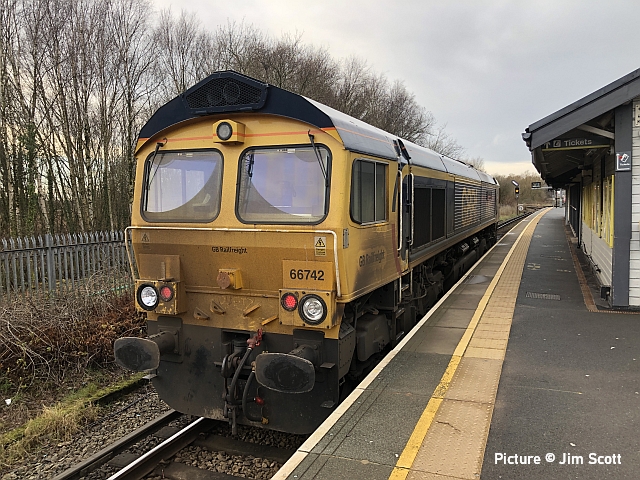
The 'road learner' at Bidston.
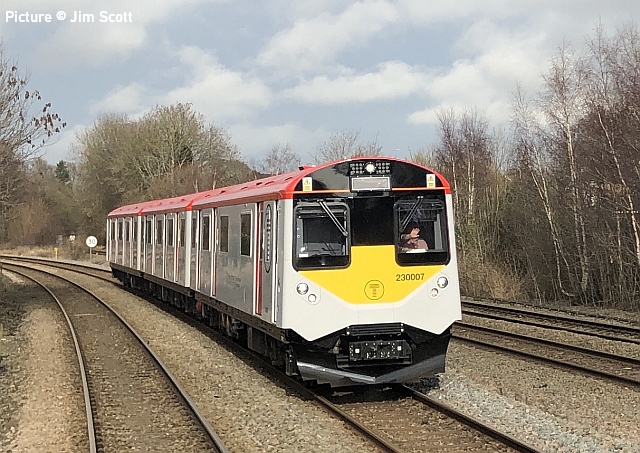
230 007 approaching Wrexham while we waited at the signal for the train in front to clear the section.
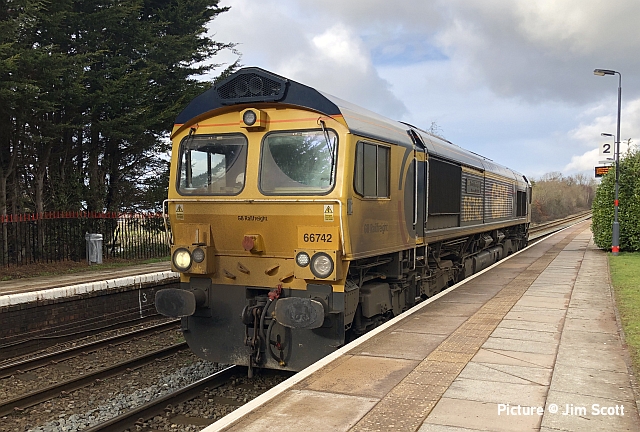
Penyffordd.
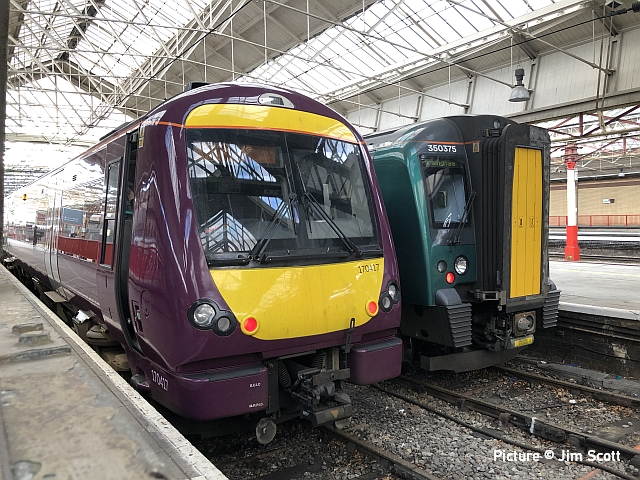
Then Monday was Crewe to Leicester: the new order in Crewe for the Derby trains, a 170 117. 350 375 behind.
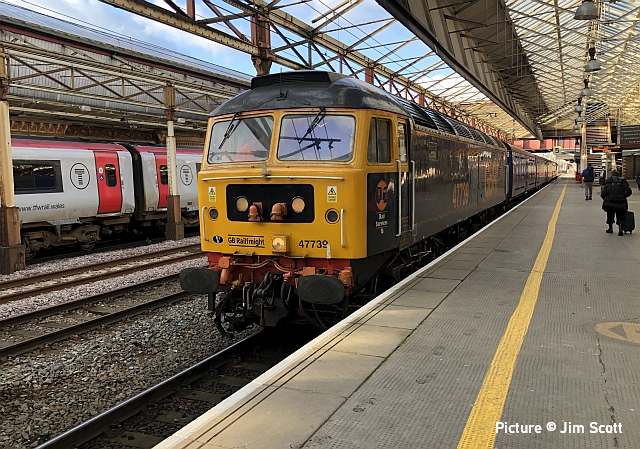
8 February: my train to Leicester, 47 739 and 56 081 top-and-tailing barrier vehicles used in moving the new Merseyrail 777 units from Crewe to Warrington for storage.
From Dave Sallery's archive
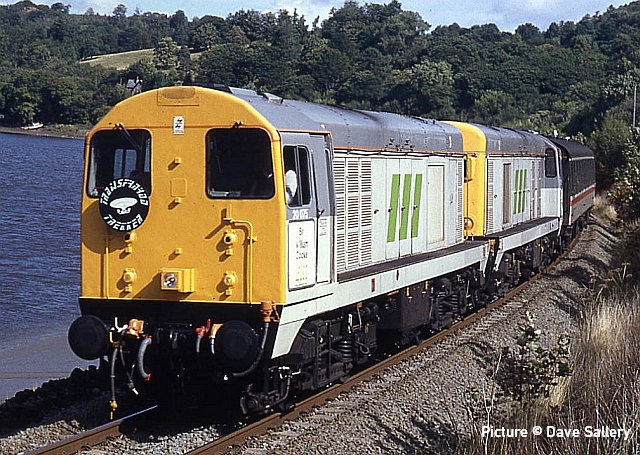
20 187 and 20 075 on the second Trawsfynydd Trekker railtour on 10 September 1994, 31 238 and 31 207 were at the other end of the six coach train.
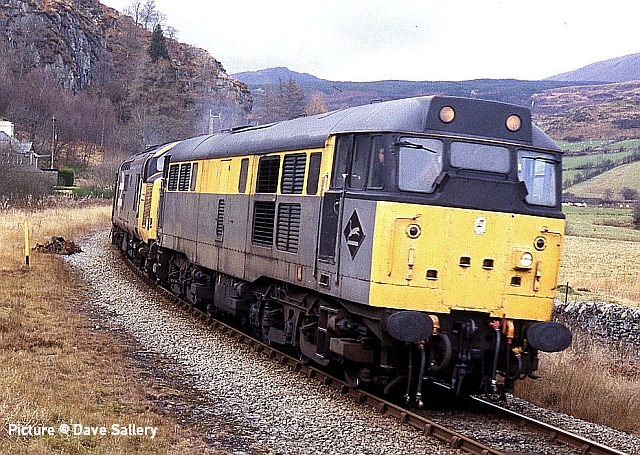
31 203 + 37 691 at Roman Bridge after re ballasting on the Trawsfynydd branch, 05 December 1993.
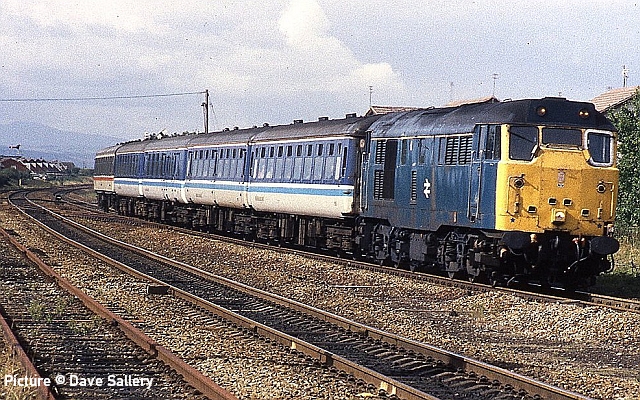
5 September 1992: 31432 on Up Passenger train at Prestatyn.
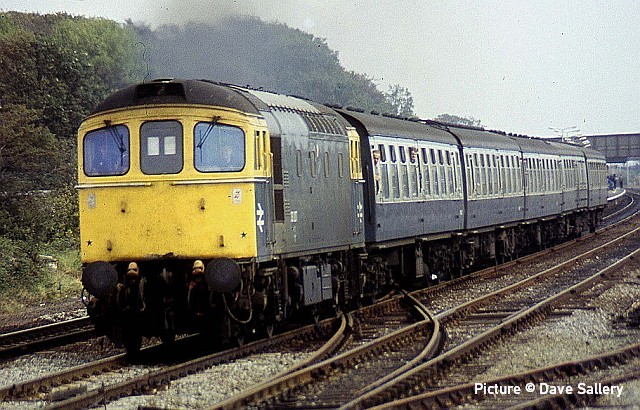
33 207 makes the last timetabled working of a Class 33 on the coast, Prestatyn, 27 September 1986. (Picture omitted from early versions of the last issue due to an editorial error.)
Borderlands notes - by John Brierley

Various Class 230 trains have been running trials on the Wrexham-Budston line . I have been looking out for 230 008 and 230 009; I think I had seen 009 on one occasion, but when I went looking for them at a decent photo location (Neston Station) on 3 Februaryat 14:32, I only found 007. I have seen a photo on the Vivarail Class 230/484 D Train group on Facebook showing 6,7 and 8 at Birkenhead on 22 December.
With the Wrexham-Bidston line from 6 - 14 Feb for Engineering work, I was keen to find out what was happening and where. On Saturday 6 February Colas 70 809 went past my house at 12:35 with used track panels n Salmon flat wagons, followed at 13:51 by 70 809 with a similar train. Later at 21: 08 70 815 passed with a train of JNA opens with some MLA opens. When I woke on Sunday 70 801 was parked on the embankment behind my house with another train of JNA opens. Presumably these had spent or fresh ballast on board.
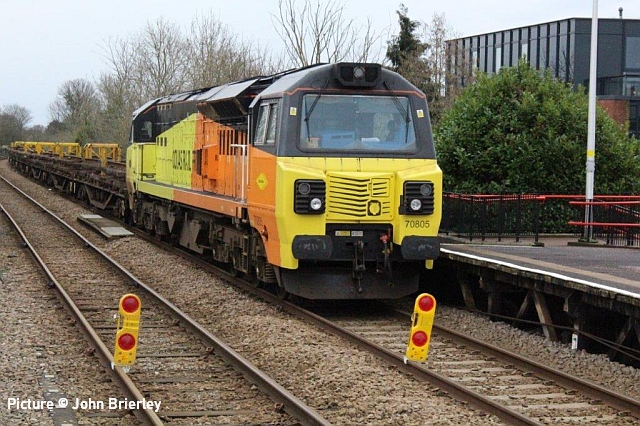
When I started to investigate I found all four trains parked nose to tail between Neston Station (above, with 70 805) and Ness Gardens, a distance of more than a mile and a half.
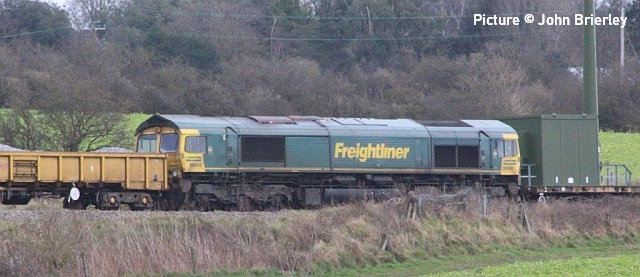
During the morning Freightliner 66 545 was attached to the Wrexham
end of the last train to haul the second ballast train away ...
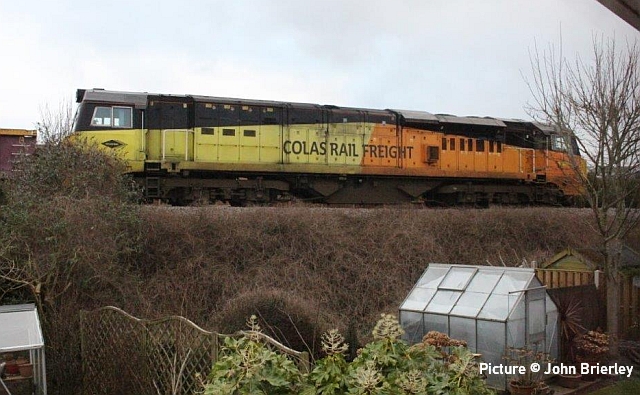
... followed at 16: 00 by 70 801 hauling the first of the ballast trains. The two track
panel trains left later, followed by the first loco 70 805.
Does anyone have details of the work done?
Funding a small Prairie - report by George Jones
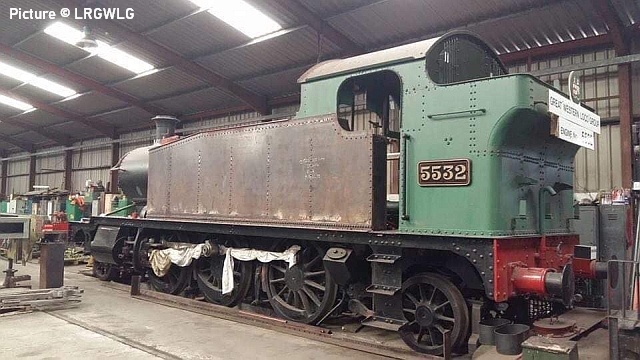
Late in 2020 the Llangollen Railway Great Western Locomotive Group (LRGWLG) highlighted the project's need to fund the re-tubing of the boiler for 'small prairie' 2-6-2T 5532 at Llangollen.
The challenge then was to raise £11k to fund the purchase of 6 large superheater tubes and 195 small tubes. Thanks to the generosity of supporters and the income from a weekly on-line raffle, all but the final £1k has now been secured leaving just 22 small tubes to be funded at £50 each before an order for the tubes can be placed with the work to be carried out at Llangollen. This is substantial progress for the restoration of this loco which was rescued from Barry scrapyard..
Looking further ahead, the re-staying of the firebox has been assessed and will call for the replacement of 8 crown stays, 35 steel stays and 120 copper stays which will come it at around £20K, if continued support for the project can be encouraged. The prospects are that the overhauled boiler may be available for installation in the locomotive during next year when a return to steam can be achieved. The small prairie will make an ideal engine for the Llangollen line when it is in service and continued support will help the Group achieve their long term aim.
The indefatigable Paul Bailey is fronting the funding appeal for the LRGWLG and can be contacted on 01490 450271 by anyone wanting to assist or else visit the project Facebook page.
The picture, courtesy of LRGWLG, shows 5532 as currently residing in the Llangollen shed sporting its replacement side tanks.
DVDs to watch - suggested by Harold Jones
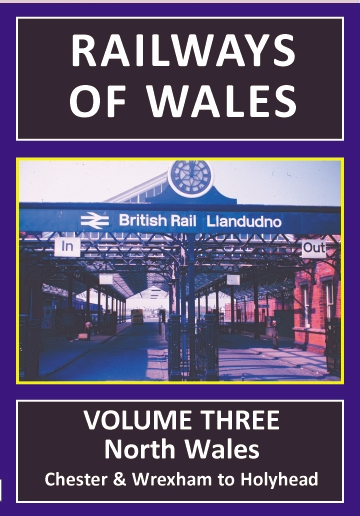
Having purchased three DVDs produced by TVP, I can thoroughly recommend volumes 1, 2, and 3 of Railways of Wales. Volume 1 covers Mid Wales, Volume 2 covers the Cambrian Coast and the Dee Valley, and recently released Volume 3 covers Wrexham, Chester and along the North Wales Coast to Holyhead (and Amlwch). The final years of steam are featured, and some early diesels.
A few hiccups, a Jubilee is called a Black Five in one shot, my other complaint is Welsh place name pronunciations. Other than that - Excellent. I have no connection with the company TVP.
The programmes are also available as downloads.
North Wales Coast home page | Archive | Previous Notice Board